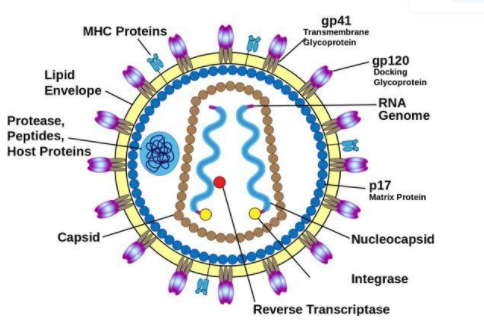
Explain the structure of HIV.
Answer
494.7k+ views
1 likes
Hint: HIV stands for Human Immunodeficiency Virus. It was discovered in 1983. It is spherical in shape and 100nm in diameter approximately. It belongs to the retrovirus family.
Complete answer:
HIV is the short form of the Human immunodeficiency virus. The shape of the virus is spherical.
The virus is made up of a capsid core which consists of the genetic material that has been covered by a protein envelope. The protein envelope contains many spikes of the glycoprotein on it. The outer part of glycoprotein is known as gp120 and it is attached to the gp41 which is the inner portion of the glycoprotein. The envelope of human deficiency virus also contains other proteins including Human Leukocyte Antigen. The genome of HIV contains two strands of RNA molecules. The enzymes reverse transcriptase is present for the conversion of the RNA to form the DNA.

HIV originated in non-human primates and eventually spread to humans. The disease was clinically diagnosed in the 1980s. Now, it has spread all over the world, killing over 25 million people. This virus has a long incubation period like 10 years long before it starts to attack the immune system. The immune system is the human body’s natural defense system HIV makes this system weak.
Note: AIDS is caused by HIV virus. IT stands for acquired immunodeficiency syndrome. This syndrome damages our immune system and reduces our body’s ability to fight with disease. It is sexually transmitted, can pass from mother to foetus, from infected blood.
Complete answer:
HIV is the short form of the Human immunodeficiency virus. The shape of the virus is spherical.
The virus is made up of a capsid core which consists of the genetic material that has been covered by a protein envelope. The protein envelope contains many spikes of the glycoprotein on it. The outer part of glycoprotein is known as gp120 and it is attached to the gp41 which is the inner portion of the glycoprotein. The envelope of human deficiency virus also contains other proteins including Human Leukocyte Antigen. The genome of HIV contains two strands of RNA molecules. The enzymes reverse transcriptase is present for the conversion of the RNA to form the DNA.

HIV originated in non-human primates and eventually spread to humans. The disease was clinically diagnosed in the 1980s. Now, it has spread all over the world, killing over 25 million people. This virus has a long incubation period like 10 years long before it starts to attack the immune system. The immune system is the human body’s natural defense system HIV makes this system weak.
Note: AIDS is caused by HIV virus. IT stands for acquired immunodeficiency syndrome. This syndrome damages our immune system and reduces our body’s ability to fight with disease. It is sexually transmitted, can pass from mother to foetus, from infected blood.
Latest Vedantu courses for you
Grade 11 Science PCM | CBSE | SCHOOL | English
CBSE (2025-26)
School Full course for CBSE students
₹41,848 per year
Recently Updated Pages
At which of the harappan sites a dockyard had been class 7 social science CBSE

Hundred rupee shares of a company are available in class 7 maths CBSE

The maximum number of representatives of the states class 7 social science CBSE

How many right angles do you make if you start facing class 7 maths CBSE

When was the Treaty of Purandar between Chhatrapati class 7 social science CBSE

What is the top of a wave called class 7 social science CBSE

Trending doubts
State and prove Bernoullis theorem class 11 physics CBSE

What are Quantum numbers Explain the quantum number class 11 chemistry CBSE

Write the differences between monocot plants and dicot class 11 biology CBSE

Who built the Grand Trunk Road AChandragupta Maurya class 11 social science CBSE

1 ton equals to A 100 kg B 1000 kg C 10 kg D 10000 class 11 physics CBSE

State the laws of reflection of light




